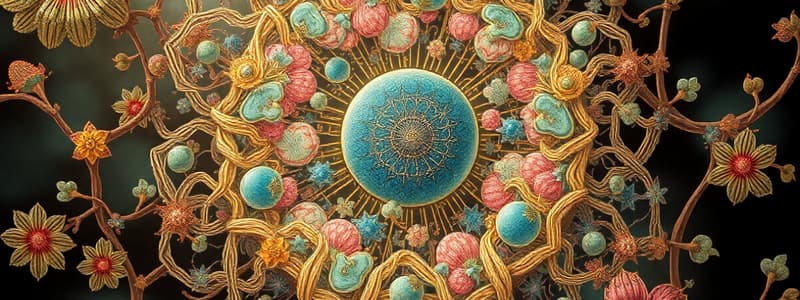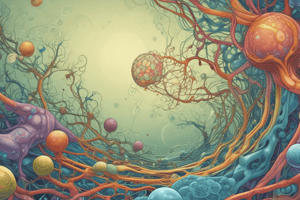Podcast
Questions and Answers
What is the primary function of mitochondria?
What is the primary function of mitochondria?
- Modification and packaging of proteins.
- Photosynthesis.
- ATP production. (correct)
- Protein synthesis.
Which statement best describes prokaryotic cells?
Which statement best describes prokaryotic cells?
- They have a complex structure with a nucleus.
- They lack membrane-bound organelles and a nucleus. (correct)
- They are generally larger than eukaryotic cells.
- They primarily perform photosynthesis.
Which process requires energy to move substances across a cell membrane?
Which process requires energy to move substances across a cell membrane?
- Active transport. (correct)
- Facilitated diffusion.
- Diffusion.
- Osmosis.
During which phase of cell division do sister chromatids separate?
During which phase of cell division do sister chromatids separate?
What defines the role of ribosomes within a cell?
What defines the role of ribosomes within a cell?
Which type of cell signaling affects nearby cells?
Which type of cell signaling affects nearby cells?
What is a key characteristic of meiosis compared to mitosis?
What is a key characteristic of meiosis compared to mitosis?
What is the primary role of the endoplasmic reticulum?
What is the primary role of the endoplasmic reticulum?
Flashcards are hidden until you start studying
Study Notes
Cell Biology
-
Cell Theory
- All living organisms are composed of cells.
- The cell is the basic unit of life.
- New cells arise from existing cells.
-
Types of Cells
- Prokaryotic Cells
- Lack a nucleus and membrane-bound organelles.
- Generally smaller (e.g., bacteria).
- Eukaryotic Cells
- Have a nucleus and membrane-bound organelles.
- Larger and more complex (e.g., plant and animal cells).
- Prokaryotic Cells
-
Cell Structure
- Plasma Membrane
- Semi-permeable barrier.
- Composed of phospholipid bilayer and proteins.
- Nucleus
- Contains genetic material (DNA).
- Controls cell activities and gene expression.
- Cytoplasm
- Gel-like substance within the cell.
- Site of metabolic processes.
- Organelles
- Mitochondria: Powerhouse of the cell, site of ATP production.
- Ribosomes: Protein synthesis.
- Endoplasmic Reticulum (ER):
- Rough ER: Studded with ribosomes; involved in protein synthesis.
- Smooth ER: Synthesizes lipids and detoxifies substances.
- Golgi Apparatus: Modifies, sorts, and packages proteins and lipids.
- Lysosomes: Contain digestive enzymes for waste processing.
- Chloroplasts (in plants): Site of photosynthesis.
- Plasma Membrane
-
Cell Membrane Transport
- Passive Transport
- No energy required; substances move down their concentration gradient.
- Includes diffusion, osmosis, and facilitated diffusion.
- Active Transport
- Requires energy (ATP); substances move against their concentration gradient.
- Involves transport proteins and pumps.
- Passive Transport
-
Cell Division
- Mitosis
- Process of somatic cell division leading to two identical daughter cells.
- Phases: Prophase, Metaphase, Anaphase, Telophase.
- Meiosis
- Division of germ cells to produce gametes (sperm and eggs).
- Involves two rounds of division resulting in four non-identical cells.
- Mitosis
-
Cell Signaling
- Mechanisms by which cells communicate.
- Involves signaling molecules, receptors, and response pathways.
- Types:
- Autocrine: Signals act on the same cell.
- Paracrine: Signals act on nearby cells.
- Endocrine: Signals (hormones) travel through the bloodstream.
-
Cellular Metabolism
- Catabolism: Breakdown of molecules to release energy.
- Anabolism: Synthesis of complex molecules from simpler ones, requiring energy.
-
Cell Cycle Regulation
- Controlled by checkpoints that ensure proper cell division.
- Key proteins: Cyclins and cyclin-dependent kinases (CDKs).
-
Stem Cells
- Undifferentiated cells with potential to develop into various cell types.
- Types:
- Embryonic Stem Cells: Pluripotent; can form any cell type.
- Adult Stem Cells: Multipotent; limited to specific lineages.
Cell Theory
- All living organisms are made up of cells, the fundamental unit of life.
- New cells arise from pre-existing cells through cell division.
Types of Cells
- Prokaryotic Cells:
- Lack a nucleus and membrane-enclosed organelles.
- Smaller in size compared to eukaryotic cells.
- Examples: bacteria.
- Eukaryotic Cells:
- Contain a nucleus and membrane-bound organelles.
- Larger and more complex than prokaryotic cells.
- Examples: plant and animal cells.
Cell Structure
- Plasma Membrane:
- A semi-permeable barrier that controls the movement of substances in and out of the cell.
- Composed of a phospholipid bilayer and embedded proteins.
- Nucleus:
- Houses the genetic material (DNA).
- Regulates cellular activities and gene expression.
- Cytoplasm:
- Gel-like substance filling the cell.
- Where many metabolic processes occur.
- Organelles: Specialized structures within the cell that perform specific functions.
- Mitochondria: Powerhouse of the cell; responsible for ATP production (energy currency).
- Ribosomes: Sites of protein synthesis.
- Endoplasmic Reticulum (ER):
- Rough ER: Studded with ribosomes, involved in protein synthesis.
- Smooth ER: Synthesizes lipids and detoxifies substances.
- Golgi Apparatus: Modifies, sorts, and packages proteins and lipids.
- Lysosomes: Contain digestive enzymes for breaking down waste materials.
- Chloroplasts (in plants): Sites of photosynthesis, converting light energy into chemical energy.
Cell Membrane Transport
- Passive Transport:
- Movement of substances across the cell membrane without requiring energy.
- Substances move down their concentration gradient (from high to low concentration).
- Examples: diffusion, osmosis, and facilitated diffusion.
- Active Transport:
- Movement of substances against their concentration gradient (from low to high concentration).
- Requires energy (ATP).
- Involves transport proteins and pumps.
Cell Division
- Mitosis:
- Division of somatic (body) cells resulting in two genetically identical daughter cells.
- Consists of four phases: Prophase, Metaphase, Anaphase, and Telophase.
- Meiosis:
- Division of germ cells (sperm and egg cells) resulting in four genetically distinct daughter cells.
- Involves two rounds of division.
Cell Signaling
- Mechanisms by which cells communicate with each other.
- Involves signaling molecules, receptors, and response pathways.
- Types:
- Autocrine: Signals act on the same cell that produced them.
- Paracrine: Signals act on nearby cells.
- Endocrine: Signals (hormones) travel through the bloodstream to distant target cells.
Cellular Metabolism
- Catabolism: Breakdown of complex molecules into simpler ones, releasing energy.
- Anabolism: Synthesis of complex molecules from simpler ones, requiring energy.
Cell Cycle Regulation
- Controlled by checkpoints that ensure proper cell division.
- Key proteins involved: Cyclins and cyclin-dependent kinases (CDKs).
Stem Cells
- Undifferentiated cells with the potential to develop into various cell types.
- Types:
- Embryonic Stem Cells: Pluripotent; able to differentiate into any cell type in the body.
- Adult Stem Cells: Multipotent; restricted to specific lineages of cells.
Studying That Suits You
Use AI to generate personalized quizzes and flashcards to suit your learning preferences.




